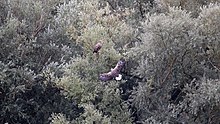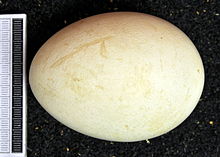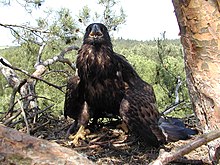Sea eagle (species)
| White-tailed eagle | ||||||||||
|---|---|---|---|---|---|---|---|---|---|---|
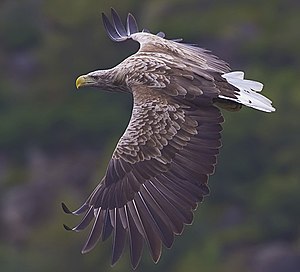
White-tailed eagle ( Haliaeetus albicilla ) |
||||||||||
| Systematics | ||||||||||
|
||||||||||
| Scientific name | ||||||||||
| Haliaeetus albicilla | ||||||||||
| ( Linnaeus , 1758) |
The white-tailed eagle ( Haliaeetus albicilla ) is a bird of prey from the hawk-like family (Accipitridae). White-tailed eagles inhabit water-rich landscapes of Eurasia from Greenland to the Pacific . They mainly feed on fish , water birds and carrion . The species was almost wiped out in Central and Western Europe by human persecution and poisoning by the insecticide DDT . Since the mid-1980s, the population has increased sharply again in large parts of Europe.
description

Eagles are among the largest birds of prey in central Europe, in the western Palaearctic only are black vulture ( Aegypius monachus ), bearded vulture ( Gypaetus barbatus ) and Griffon vulture ( Gyps fulvus ) is greater.
When seated, white-tailed eagles can usually be recognized by their size, the somewhat angular-looking, very strong and almost brawny body, the very strong and long neck, the large muzzle and the very strong legs, even at a great distance . The plumage of adult sea eagles is predominantly brown. The head, neck, upper chest and upper back are lightened yellowish-ocher. The white streak is short and wedge-shaped. The catch is very large compared to other birds of prey and powerful, and as the cere light yellow. The irises of the eyes are also light yellow. Unlike the golden eagle ( Aquila chrysaetos ), the legs are not feathered down to the toes.
In Central Europe, sea eagles can hardly be mistaken for flight. In addition to its significant size, its long, powerful neck and wide, board-shaped wings, which are held horizontally in gliding , are good distinguishing features. At a higher altitude, the white joint is often barely visible, the flight image is then often described as a "flying scaffolding board". In active flight, the huge wings are thrown far down and up.
Young sea eagles are dark brown, the muzzle and wax skin are dark gray. With each moult they become more similar to the adult animals, at five years of age they show the full adult dress. Immature white- tailed eagles are sometimes confused with young golden eagles because of their often well-developed dark butt-end band . Based on the very different body proportions and the lack of light wing fields in white-tailed eagles, however, the species can be easily distinguished.
White-tailed eagles reach a body length of 74 to 92 centimeters and a wingspan of 193 to 244 centimeters. With a weight of 3.7 to 6.9 kilograms and a wing length of 621 to 717 millimeters, the females are on average significantly larger and heavier than the males with 3.1 to 5.4 kilograms and a wing length of 552 to 652 millimeters.
No subspecies are described for the white-tailed eagle today . In the past the sea eagles were separated from the nominate form as a separate subspecies on Greenland , but this separation is no longer maintained today. Genetic studies have confirmed the relatively close relationship between the Greenlandic sea eagles and sea eagles from Western Europe. Presumably, the Greenland population goes back to a settlement by European sea eagles after global warming since the last Ice Age (<15,000 years). However, the sea eagles in Iceland and Greenland do not seem to be linked to European sea eagles by gene flow these days .
The sea eagle is very similar to the American bald eagle in appearance, behavior and ecology . Some authors therefore combine these two species into one superspecies .
Vocalizations
The sea eagle's courtship “song” is a relatively high and somewhat hoarse series of calls, often uttered in a duet, such as “klü, klü, klü, klü, klü” or “rick, rick rick”, which becomes higher towards the end; the head is thrown upwards. The call series resembles the call of the black woodpecker at a greater distance . The call is almost only uttered in the vicinity of the eyrie, and there especially at dawn and dusk. In the event of disturbances at the eyrie , the adult birds call continuously hoarse and choppy "ak, ak, ak, ak, ak"; the young birds in the eyrie make the same call when they approach.
distribution and habitat
The distribution of the white-tailed eagle stretches across the temperate, boreal and arctic zones of Europe and Asia from Iceland to Ireland to Kamchatka and Japan . Greenland is also inhabited by the species. In Europe, the breeding area extends in a north-south direction from the northern tip of Norway to northern Greece . In Central Asia, the northern border of the distribution roughly follows the northern border of the taiga , in the south the distribution border is in Israel , Turkey , Iraq , Iran and Kazakhstan .
The white-tailed eagle is bound to large bodies of water, i.e. coasts , large lakes and rivers. In inland Central Europe, white-tailed eagles are mainly residents of the “forest-lake landscapes”. In Germany, the highest settlement densities are reached in the Müritz area in Mecklenburg-Western Pomerania and in Upper Lusatia in Saxony .
hikes
Adult sea eagles are resident birds in almost all of Europe and stay in their territory all year round. Young and immature white-tailed eagles as well as adult non-territorial birds roam widely in Europe in search of cheap food. The sea eagles in northern Russia and Siberia are migratory birds . They overwinter on Hokkaidō and in Korea , in South China and in North India , in Pakistan and further west often on the Caspian Sea , rarely in Arabia , Turkey and Cyprus .
There were five main wintering areas in Austria in the winter of 2011/2012. These were the March-Thaya floodplains in the border area with Slovakia and the Czech Republic, the Parndorfer Platte in the north of Burgenland, the Burgenland Seewinkel including the border area with Hungary ( Hanság ), the Danube floodplains near Vienna and the north-eastern Waldviertel . In February 2012, the WWF counted 159 hibernating sea eagles in Austria.
nutrition
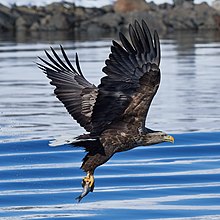
The white-tailed eagle feeds primarily on fish and waterfowl during the breeding season , carrion is also popular, living mammals usually only play a subordinate role. Fish are often self-captured, but sea eagles also eat dead and half-decayed fish. The most common species in the respective habitat also predominate in the food spectrum of the white-tailed eagle.
In Schleswig-Holstein fish make up 73% and waterfowl 24% of the prey. The remaining 3% are mammals , mainly rabbits and brown hares . Among the fish, lead with 24%, carp with 23% and indefinite carp fish ( Cyprinidae ) with 29% dominate. The most commonly captured waterfowl are coot (56%), gray goose ( 10%) and mallard (6%).
In the winter months, the proportion of waterfowl rises considerably and makes up around 80% of the prey in Central European inland areas. Especially in winter also plays Aas a significant role.
The fish prey of the sea eagles living on the Finnish Baltic Sea coast consists mainly of pike and aland during the breeding season , among the birds here the eider duck and various sawsmen ( Mergus sp. ) Dominate , although the proportions vary greatly from region to region. On the Aland Islands in southwestern Finland were eider with 19.4% the most common prey, followed by Hecht (15.5%), various sawyers (11.1%), Aland (6.4%) and Tufted (4, 4%). In the area around the city of Vaasa on the west coast of Finland, pike dominated the bag list with 31.7%, followed by sawdaws (10.7%), the eider (10.5%) and the tufted duck (8.7%).
On the northern Russian Kola Peninsula , white-tailed eagles live mainly on Alanden (49.1%), followed by pike (16.7%) during the breeding season. Waterfowl made up 20.3% of the bag list, mammals 4.9%.
Fish also dominate the diet in the extreme east of the range. On the lower Amur , 4 species of fish ( gable , Amur pike ( Esox reicherti ), Amur catfish ( Parasilurus asotus ) and Amur spiny catfish ( Pelteobagrus fulvidraco )) made up 93.8% of the prey during the breeding season.
Loot acquisition
The methods used by the white-tailed eagle to acquire prey are very diverse. Eagles use for finding food to the aquatic environment preferably low-noise seat Wait , of which they wait for hours for a chance to loot assistance. The simplest "hunting method" is to collect half-dead or dead fish from the surface of the water. Just like living fish, they are grabbed out of the water by the eagle flying low over the water as it flies by. Large fish weighing more than 2 kilograms are grabbed and held in the water near the bank. The eagle can lie on the water with outstretched wings for a few minutes in deeper water. When the fish is tired of fighting, the eagle swims ashore with its prey.
Healthy ducks and geese immediately fly up when a sea eagle attacks and are then no longer pursued. However, the eagles use favorable opportunities, for example shot or sick birds, in summer especially young birds that have not yet fledged and flightless birds in full moults, in winter for example birds frozen in the ice. Coots do not fly up when a sea eagle attacks, but close together and run across the water as a closed group flapping their wings. The resulting noise can be heard from afar. Winter gatherings of waterfowl in ice holes often attract large numbers of sea eagles. The Eagles shake then clumsily over the ice hole and capture the waterfowl targeted shock flights.
Individual diving ducks , grebes or coots that evade attacks by diving are forced to dive by the repeatedly attacking eagle until they are exhausted and then grabbed. This hunting method is particularly efficient when both partners of a couple take turns attacking.
During the breeding season, colonies of cormorants and gray herons , in Northern Europe also guillemots and other sea birds , sea eagles are regularly visited and young birds are captured from their nests. In cormorant colonies, sea eagles also collect the fish that the cormorants have strangled from the bottom. It was only in the last few years that it became known that sea eagles also regularly eviscerate birds of prey. For example, dead or even still living nesting buzzards have been found several times in sea eagle nests .
Especially in winter, white-tailed eagles look systematically for carrion. Large mammals such as red deer and wild boar are also used. The eagles observe ravens and crows, among other things , which often gather in large swarms on such carcasses. On railway lines, white-tailed eagles regularly eat animals that have been run over, in areas with regular hunts, white-tailed eagles often look for organs left behind by the hunted animals, the departure . However, both are not without danger for the eagles (see section Life Expectancy and Mortality ).
Sea eagles usually try to get food with as little effort as possible and often appear clumsy and sluggish, on the other hand, the speed and agility that this eagle can develop are often underestimated. In normal flapping flight, sea eagles fly at around 60 km / h and are easily able to overtake common ravens, for example. The capture of gray herons and geese in the open air has been observed several times. White-tailed eagles parasitize other species very well, especially ospreys ( Pandion haliaetus ) are regularly hunted for their prey. Finds of smaller birds such as adult jays , magpies or woodcock in sea eagle nests have shown that apparently medium-sized birds of prey such as hawks and peregrine falcons are also parasitized by sea eagles.
Social behavior
Old sea eagle pairs live together in permanent marriage and show impressive courtship flights , especially in winter . During the courtship flights, synchronized flights, common circles and playful clashes alternate. Flight activity is particularly high on sunny days with strong winds.
Young and not yet colored conspecifics are mostly ignored by territorial adult birds and tolerated in the territory. Colored alien eagles are immediately and violently attacked and driven from the area. The attacked alien eagle usually leaves the couple's territory as quickly as possible. However, white-tailed eagles are regularly found in breeding areas, which have been seriously injured or killed in struggles for internal damage . Such fights probably occur when the bird in possession of the territory is weakened by old age, minor injuries or the like and the invading bird sees a chance to take over the territory.
Young and immature eagles join together to form larger groups, especially in places rich in food, and use shared sleeping areas. In places with a high supply of food, such as when fishing in ponds or on large carcasses, there are often 20 or more sea eagles. Playful scuffles for prey or the best resting places are common within these groups.
Reproduction
White-tailed eagles build huge nests from branches. The nest hollow is lined with grass and moss. In Central Europe, old trees are used for nesting, in northern Germany mainly red beeches , in eastern Germany, in addition to red beeches, mainly Scots pines . New clumps have a diameter of about 1.2 to 1.5 meters and a height of 50 to 80 centimeters, old clumps that have been used for decades can have a diameter of two meters, a height of three to five meters and a weight of 600 kilograms to reach. On the coasts of Northern Europe, for example in Norway , many white-tailed eagles breed in cliffs, and on remote and treeless islands on the ground. Many districts have one or more alternating nests, which are often used alternately for decades.
In Central Europe, breeding begins between mid-February and mid-March. The clutch consists of one to three white eggs and the incubation period is around 38 days. The young birds reach the branching stage after around 75 days and after 80 to 90 days they can fly short distances.
Age of breeding birds
The mortality in the first years of life is very low compared to smaller species of birds of prey. In a study in Norway, young sea eagles were provided with satellite transmitters; at least 86% of all young birds survived the first two years of life. In Finland, mortality was calculated from readings of ringed birds at feeding stations and was 14% up to the first winter (i.e. from ringing to winter in the year of ringing), 7% from first to second winter, and from second to third Winter 4%. Comparable studies are not yet available from Central Europe.
Information on the average age of breeding birds is available from Schleswig-Holstein. In 2006, 35 ringed breeding birds were identified, they were 4–20 years old, with an average of 10.3 years. The majority of the birds (80%) were between 6 and 14 years old.
The most important natural cause of loss is injuries during turf wars.
mortality
The mortality in Central Europe is currently primarily due to human influences. These include, in particular, deaths as a result of lead poisoning through the ingestion of lead particles from hunting bullets, collisions with railways, overhead lines and wind turbines, and electric shocks on high-voltage lines. The frequency of such deaths can vary greatly from region to region. In Schleswig-Holstein, a federal state with a high proportion of wind turbines, collisions with wind turbines are by far the most common known cause of death.
Of 87 sea eagles from Germany found injured or weakened between 1998 and 2006, 33% had lead poisoning, 12% had collided with technical equipment, and 5% were victims of electric shocks. Another 22% also had approach injuries such as broken bones and the like, without the cause being able to be determined, since many of these birds had apparently been unable to fly for days or weeks and had covered long distances on foot. Injuries caused by intra-species territorial fights were found in 9% of the found animals; these only occurred in adult and immature eagles. In contrast to smaller bird of prey species, in which the greatest mortality in young birds occurs in the first year of life, 43% of the birds found were adult, another 18% were immature and only 39% were nestling or in youthful dress. Of the 23 nestlings and fully fledged sea eagles recorded in this study, 11 also had the pinching-off syndrome , a presumably genetically caused severe fletching disorder. Without this disease, which so far only occurred in Central and Western Europe, the proportion of young birds would have been significantly lower.
Lead poisoning is due on the one hand to lead shot , as it is used for hunting waterfowl, pigeons, pheasants, and foxes, but above all to lead-containing bullet ammunition with which cloven-hoofed animals (including roe deer , deer and wild boar ) are hunted. These projectiles splinter on impact and contaminate large parts of the animal's body with splinters of lead. Especially in winter, white-tailed eagles systematically search for carrion and then use the innards left by the hunter at the location of the kill, as well as animals that were shot at and not found despite being searched. The acidic gastric juices of the sea eagle dissolve lead very quickly and it gets into the bloodstream. The toxic heavy metal damages the central nervous system and blood formation in eagles, among other things . This often leads to central nervous system deficits up to complete blindness. The disruption of blood formation leads to a lack of oxygen, so many of the eagles suffocate. Scientists assume that some of the collisions with anthropogenic structures such as trains or wind turbines can also be traced back to behavioral disorders caused by lead poisoning. Lead-free alternative ammunition has been available for a long time. The state forest administrations of the states of Berlin and Brandenburg have taken the first steps to ban leaded bullet ammunition .
In winter 2016/2017 there were at least 17 confirmed deaths in Mecklenburg-Western Pomerania, Schleswig-Holstein, Lower Saxony and Hamburg as a result of an infection with the H5N8 influenza virus .
Population development and endangerment
As part of the general practice of tracking all birds of prey from around the middle of the 17th century, sea eagles were also intensively pursued in large parts of their range. By the beginning of the 20th century they had been exterminated in all of Western Europe, the westernmost occurrences were in Central Europe at that time in today's federal states of Mecklenburg-Western Pomerania and Brandenburg . The occurrences in Scandinavia and Finland had also disappeared except for small remains. From the beginning of the 20th century, there were first protective efforts, which were significantly intensified throughout Europe in the 1920s, especially by a book by Bengt Berg , The Last Eagles . The populations showed significant increases due to the hunting protection. During this time, Schleswig-Holstein (1947) and Denmark (1952) , among others, were repopulated.
In the 1950s and 1960s there was a rapid decline in populations again, as the birds hardly had any offspring. This was due to the consequences of using DDT . The insecticide DDT and its metabolite DDE , which was widely used worldwide after 1945, accumulated heavily in the food chain, especially in aquatic habitats, and led to thin eggshells in sea eagles and other birds of prey. The eggs broke or died during incubation. With the ban on DDT from the beginning of the 1970s, the stocks recovered; since 1990 many populations , including the German one, have shown strong growth and a clear tendency to spread. The number of breeding pairs in Germany rose from 185 in 1990 to 470 in 2004, and in 2007 there were 575 breeding pairs in Germany. In 2018, 700 breeding pairs were counted in Germany, 391 of them in Mecklenburg-Western Pomerania. This corresponds to an annual growth of 20%. Similar developments took place in Poland , Finland and Sweden. The Czech Republic (1984), Lower Saxony (1987), Denmark (1995), Austria (2001), Bavaria (2006) and the Netherlands (2006) were repopulated. Population estimates currently assume up to 12,000 breeding pairs worldwide.
Genetic studies have shown that local conservation of sea eagles has been a great success for conservation. The ban on DDT use, local nest protection, winter feeding and the countless other protective measures in many countries have resulted in the white-tailed eagle population recovering in the region. As a result, despite the massive decline in populations during the 19th and 20th centuries, a lot of genetic variation remained. Conservation biologists see this fact as an important factor for the long-term survival of the species.
The IUCN listed the white-tailed eagle as “endangered” until 1993, in 1994 the species was downgraded to “low endangered” due to the population increase and in 2005 to “not endangered”. In some federal states, however, the white-tailed eagle has been classified as "critically endangered" since 2015.
A first census coordinated in nine countries by 300 people along the entire Danube on Sunday, January 12, 2014, showed that 3000 river kilometers in winter are populated by 750 specimens of this species. On about 400 km of the river in (or on) Austria, 35 pieces of his heraldic bird were counted, which was considered extinct here after targeted persecution since 1946, but has been breeding again since 2001 after protective measures.
literature
- J. Ferguson-Lees, DA Christie: Raptors of the World. Christopher Helm, London 2001, ISBN 0-7136-8026-1 , pp. 112-113, 402-406.
- W. Fischer: The sea eagles. Wittenberg 1984. ISSN 0138-1423
- B. Helander, M. Marquiss, W. Bowerman: Sea Eagle 2000 . Stockholm 2003, ISBN 91-558-1551-0 .
- Sea eagle protection project group Schleswig-Holstein: 30 years of sea eagle protection in Schleswig-Holstein . Kiel 1998.
- OAG, Ornithological Working Group for Schleswig-Holstein and Hamburg eV (ed.): Corax, special issue. 1, 19, 2002 ( online ) (special issue on the sea eagle in Europe).
Web links
- Sea eagle project of WWF Austria
- Project group Sea eagle protection Schleswig-Holstein
- Leibniz Institute for Zoo and Wildlife Research (IZW): Lead poisoning in white-tailed eagles: causes and possible solutions
- Live webcam nest in Latvia
- Haliaeetus albicilla in the endangered Red List species the IUCN 2008. Posted by: BirdLife International, 2008. Accessed October 13 of 2008.
- Videos, photos and sound recordings for Haliaeetus albicilla in the Internet Bird Collection
- Feathers of the sea eagle }
Individual evidence
- ^ J. Ferguson-Lees, DA Christie: Raptors of the World. Christopher Helm, London 2001, ISBN 0-7136-8026-1 , p. 406.
- ↑ F. Hailer, B. Helander, AO Folkestad, SA Ganusevich, S. Garstad, P. Hauff, C. Koren, VB Masterov, T. Nygård, JA Rudnick, S. Saiko, K. Skarphedinsson, V. Volke, F Wille, C. Vilà: Phylogeography of the white-tailed eagle, a generalist with large dispersal capacity. In: Journal of Biogeography. Volume 34, Issue 7, 2007, pp. 1193-1206. doi: 10.1111 / j.1365-2699.2007.01697.x
- ^ BirdWatch Ireland: White-tailed Eagle. (No longer available online.) Archived from the original on August 22, 2018 ; Retrieved August 22, 2018 (American English).
- ↑ wwf.at on the WWF Austria website, accessed on March 22, 2012.
- ↑ B. Struwe-Juhl: Why do White-tailed Eagles prefer coots? In: B. Helander, M. Marquiss, W. Bowerman (Eds.): Sea Eagle 2000 . Proceedings from an international Sea Eagle Conference at Björko, Sweden, September 13-17, 2000. Swedish Society for Nature Conservation / SNF & Atta. 45 Tryckeri AB. Stockholm 2003, ISBN 91-558-1551-0 , pp. 317-325.
- ^ S. Sulkava, K. Huhtala, R. Tornberg: Summer diet of the White-tailed Eagle in Finland in the 1990s. In: B. Helander, M. Marquiss, W. Bowerman (Eds.): Sea Eagle 2000 . Proceedings from an international Sea Eagle Conference at Björko, Sweden, September 13-17, 2000. Swedish Society for Nature Conservation / SNF & Atta. 45 Tryckeri AB. Stockholm 2003, ISBN 91-558-1551-0 , pp. 307-314.
- ↑ VB Masterov: Resource consumption and energy expenses of Steller's and White-tailed Sea Eagles in the mixed settlements of the far east of Russia. In: B. Helander, M. Marquiss, W. Bowerman (Eds.): Sea Eagle 2000 . Proceedings from an international Sea Eagle Conference at Björko, Sweden, September 13-17, 2000. Swedish Society for Nature Conservation / SNF & Atta. 45 Tryckeri AB. Stockholm 2003, ISBN 91-558-1551-0 , pp. 327-339.
- ↑ z. BM Müller, T. Lauth: Rearing of a young buzzard Buteo buteo in a brood of the white-tailed eagle Haliaeetus albicilla does not end successfully. In: Orn. Newsletter Meckl.-Vorp. Volume 45, No. 4, 2006, pp. 399-401.
- ↑ T. Nygård, RE Kenward, K. Einvik: Radio telemetry studies of dispersal and survival in juvenile white-tailed sea eagles Haliaeetus albicilla in Norway. In: RD Chancellor, B.-U. Meyburg: Raptors at risk. 2000, pp. 487-497.
- ↑ P. Saurola, T. Stjernberg, J. Högmander, J. Koivusaari, H. Ekblom, B. Helander: Survival of juvenile and sub-adult Finnish white-tailed eagles in 1991–1999: a preliminary analysis based on resightings of color -ringed individuals. In: Sea Eagle 2000. 2003, pp. 155-167.
- ↑ B. Struwe-Juhl, T. Grünkorn: Results of the color ringing of sea eagles Haliaeetus albicilla in Schleswig-Holstein with information on local loyalty, resettlement, dispersion, sexual maturity, age structure and sibling mating. In: Vogelwelt. Volume 128, 2007, pp. 117-129.
- ↑ Annual report 2012 for hunting and species protection. in Schleswig-Holstein. Ministry for Energy Transition, Agriculture, Environment and Rural Areas, 2012, p. 96.
- ↑ K. Müller, R. Altenkamp, L. Brunnberg: Morbidity of Free-ranging White-tailed Sea Eagles Haliaeetus albicilla in Germany. In: Journal of Avian Medicine and Surgery. Volume 21, No. 4, 2007, pp. 265-274. PMID 18351005
- ↑ A. Trinogga, O. Krone: wound ballistics of common lead-containing and lead-free rifle bullets. In: O. Krone: Lead poisoning in sea eagles: causes and approaches. Leibniz Institute for Zoo and Wildlife Research (IZW), Berlin 2008, ISBN 978-3-00-025829-9 , pp. 8-20.
-
↑ T. Langgemach, N. Kennner, O. Krone, K. Müller, P. Sömmer: Notes on lead poisoning of sea eagles (Haliaeetus albicilla). In: Nature and Landscape. Volume 81, No. 6, 2006, pp. 320-325 ( full text as PDF ( Memento from February 1, 2012 in the Internet Archive ))
- N. Kennner, G. Oehme, D. Heidecke, F. Tataruch: Retrospective study on lead intoxication and exposure to potentially toxic heavy metals from sea eagles Haliaeetus albicilla in Germany. In: Vogelwelt. Volume 125, 2004, pp. 63-75.
- ↑ Norbert Kenntner, Frida Tartaruch, Oliver Crown: Heavy metals in soft tissue of white-tailed eagles found dead or moribund in Germany and Austria from 1993 to 2000. In: Environmental Toxicology and Chemistry . Volume 20, No. 8, 2001, pp. 1831-1837.
-
↑ Oliver Krone, Anja Globig, Reiner Ulrich et al .: White-Tailed Sea Eagle (Haliaeetus Albicilla) Die-Off due to Infection with Highly Pathogenic Influenza Virus, Subtype H5N8, in Germany. In: Viruses. Volume 10, No. 9, 2018, No. 478, doi: 10.3390 / v10090478
Scientists for the first time detect fatal bird flu infection in white -tailed eagles. On: idw-online.de from October 4, 2018. -
↑ F. Hailer, B. Helander, AO Folkestad, SA Ganusevich, S. Garstad, P. Hauff, C. Koren, T. Nygård, V. Volke, C. Vilà, H. Ellegren: Bottlenecked but long-lived: high genetic diversity retained in white-tailed eagles upon recovery from population decline. In: Biology Letters. Volume 2, No. 2, 2006, pp. 316-319. doi: 10.1098 / rsbl.2006.0453 PMC 1618921 (free full text)
- Frank Hailer: Conservation genetics of the white-tailed eagle (Haliaeetus albicilla) . PhD thesis. Uppsala University, 2006. (Thesis summary)
- F. Hailer, B. Gautschi, B. Helander: Development and multiplex PCR amplification of novel microsatellite markers in the White-tailed Sea Eagle, Haliaeetus albicilla (Aves: Falconiformes, Accipitridae). In: Molecular Ecology Notes. Volume 5, No. 4, 2005, pp. 938-940. doi: 10.1111 / j.1471-8286.2005.01122.x (abstract)
- ↑ Thorsten Krüger, Markus Nipkow: Red list of the endangered breeding birds in Lower Saxony and Bremen . 8th version, as of 2015. Ed .: Lower Saxony State Agency for Water Management, Coastal and Nature Conservation. tape 35 , no. 4 . Hanover April 2015, p. 194 .
- ↑ 750 sea eagles along the Danube. ORF.at from January 13, 2014.


